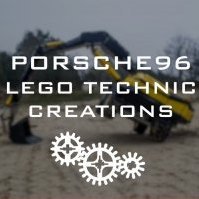Search the Community
Showing results for tags 'RC'.
Found 538 results
-

[MOC] RC Nova futurecar (finished)
syclone posted a topic in LEGO Technic, Mindstorms, Model Team and Scale Modeling
Powered by BuWizz V1. Drive: 1x M-motor. Steering: 1x M-motor Video: WIP photos:- 9 replies
-
- futuristic
- buwizz
-
(and 1 more)
Tagged with:
-
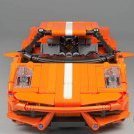
RC Car Toy Story
Leviathan posted a topic in LEGO Technic, Mindstorms, Model Team and Scale Modeling
Hi everyone, Here is my last original creation : The RC Car from Toy story movie ! I would like to make a RC car controlled by smartphone and easily recognizable by young people (and older one too...) Features : RWD by 2 L motors Steering by 1 Servo motor Controlled by 1 Sbrick (or 1 Buwizz without bbox) Independent suspensions External switch for power supply Some nice colors I used 2 pythagoriciens triplets to improve chasis stiffness. The car is divided in 3 modules : front, motors and rear In the picture below you can see red bush on 4l axle with stop. It's the switch to power up or down the battery box. I used Anto's buggy motorisation : http:// http://www.techlug.fr/Forum/viewtopic.php?f=5&t=11544 but il replaced 8t by 24t. HD photos gallery : https://www.flickr.com/photos/147164115@N07/albums/72157713497548457 Building instructions are available : https://rebrickable.com/mocs/MOC-39835 I added 3x3 lime dish for the eyes on 3D model : I hope you'll like it, See you soon ! -

[MOC] RC itasha tuner "2BX" + video
syclone posted a topic in LEGO Technic, Mindstorms, Model Team and Scale Modeling
Hello, here's a thing I've been working on and off for some time now. Started off a as drift car in 1/11th scale, but then just flowed down into a simple street tuner build. Itasha definition from Wikipedia - In Japan, an itasha is a car decorated with images of fictional characters of anime, manga, or video games. Features: Openable scissor doors, bonnet and boot NOS and TV screen in the boot Interior with steering wheel, bucket seats, "rollcage" and audio system. "Engine cover" with turbo and honeycomb airfilter RC via BuWizz Drive with 2x buggy motors from fastest output Steering with m-motor Custom graphics of C.C. from Code Geass (linked in my signature) as well as sparco, koni and buwizz "sponsor" decals Sorry for crappy photos, only have smartphone at hand. I'll try to film it driving indoors or sneak into the building's hallway today or tomorrow. Cya! -

The Handful of Buggy 4x 5292
AndyCW posted a topic in LEGO Technic, Mindstorms, Model Team and Scale Modeling
Hello All, It has been ages since I shared something on here, even though I visit daily to see everyone else's builds. However, 'recent events' have given me more time to build. I haven't been idle these last couple of years, but nothing I made rose to the level of sharing. The following buggy has four unrestricted 5292 motors, at 12.6 volts, going to the rear wheels and only weighs 1400 g. This makes it hard to handle for the inexperienced driver. The rubber bands on the rear control arms keep the ball sockets from coming apart. The lower arms are different from the upper ones due to the change in position of the joints on the swing arm through the suspension cycle. This also creates a rather nice camber curve. I also discovered a weakness in the stiff springs. The upper mount will shear off of the side of the shock body if it is used. Many of my shocks have stress fractures there. I've got to clean the thing up now, it is covered in mud. I wonder who did that. Question, concerns, comments, or relevant war stories? v/r Andy -
This is my first post that I was so confused about which theme I should post in: train? technic? scale modeling? I finally choose train tech just because it's a train after all If I made a mistake that put it in the wrong place, please forgive me. Actually I created a MOC train that is a 1:35 scale model and also with technic internal though it looks like ordinary stud-built. It's a model but not only looks look. It should be able to do something like the real one. 1, Origin It won't be happy if a man never creates something. Since my kid likes train toys very much, I start to focus on rail transportation. I found Lego's official sets are quite compromised since they need to match the mass need. The traditional scale train models are normally small and very expensive which is also hard to get in China especially one delicate like Marklin(okay, it's because of the price). We are AFOL, so I must have a scale train model, not a toy. 2, about type Targeting train is also in very straightforward logic. I am ready to build "Dora" (Heavy Gustav) as the showdown to my kid. I will tell him nothing is necessarily built on the rail after completion of this ultimate rail machine of all the time in history. Heavy Gustav cannot move by itself, I need locomotives. yes, before any creation on the rail, the locomotive is the prerequisite. That would be very clear, D311 diesel-electric locomotive was specialized built for "Dora" by Krupp. Two groups of double D311 drive "Dora" to move with each on two four-axis chassis. pic1: D311/V188 in WWII D311 WWII by Nash Liu, on Flickr 3, Scale It is a scale model that also needs to run on standard 9V track. The scale bases on the gauge of track known as L-gauge scale that is between 1 and O gauges. I choose 1:35 because there are the most resources of 1:35 Military models When TAMIYA continually push this scale. pic2: a scratch build D311 static model with 1/35 Scratch Build 1/35 D311 Model by Nash Liu, on Flickr 3, Exterior The ordinary stud brick build is always more graceful and beautiful showing than technic build. There is no weird gap and abstract design like technic exterior. However, the stud brick is not flexible to show various details and often takes up a lot of space. SOT can show as one stud, but SNOT often has to spend 2 studs to show different details. If Lego develops more special bricks and plates for combination and detail showing, the precision of the Lego model will be up to another level. Maybe Lego's official target is only toy. pic3: what this lego train model looks like(I don't have enough unicolor bricks, so I post computer rendering graph) MOC D311 Diesel Electric Locomotive 1:35 Exterior by Nash Liu,on Flickr 4, Interior Beside exterior, the model is ensouled by the functions that should be capable like its true body. D311 is the most powerful locomotive at that time, so the model also should be the most powerful train in the lego universe. pic4: super compact technic design with 4 motors that are parts of load-bearing MOC D311 Diesel Electric Locomotive 1:35 Interior by Nash Liu, on Flickr 5, Extreme Design What is an extreme design? Simply speaking, it is not a waste of one stud. Designers are very likely to MOC without limits. We can often find super complex and magnificent masterpieces on the web. But the model should have confine, at least confined by scales and functions. From the above, I list the following features. 1, Dual XL motors 2, Dual stepper motors for clutch and gearbox 3, Dual 8881 battery boxes that contain 12 AA batteries for the enormous duration 4, 2-speed gearbox 5, differential adder for XLs coupling 6, clutch between 8x8 and 8x4 driven 7, bogie integrated driven system pic5: a prototype that shows adder, XLs, steppers, and general structures Prototype PowerFunction D311 by Nash Liu, on Flickr 6, work with its couple The ultimate Gustav is still a blueprint in my brain. Many guys including me are curious that what they look like when Gustav is moving in history. I build GCs and PS with an appropriate scale. the model of Gustav is 1:72 normal design. I scale down D311 to match 1:35 by PS(Sorry, who can tell me which CAD can change design size by scale?) I CANNOT wait to build 1:35 with extreme design. Although the specification is not clear yet, one thing I can make sure and a super exciting feature is how to make this giant millipede turn on Lego standard track. It should be very magnificent. Heavy Gustav with 4 D311 by Nash Liu, on Flickr
- 26 replies
-
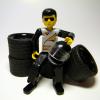
[MOC] Datsun 240Z
legomarat posted a topic in LEGO Technic, Mindstorms, Model Team and Scale Modeling
My latest MOC. Wangan Midnight Devil Z. Power: 2 RC motors and 2 88000 battery boxes. PF servo for steering and Sbrick for control. Full Independent suspension. Link to video- 23 replies
-
- model team
- RC
-
(and 2 more)
Tagged with:
-
Hi there, I'd like to present a MOC I've been working on from time to time since a few months: It's a small RC buggy, something I'm missing from Lego: Pictures show the V2 model. An interactive 360° view of the V1 model (with different rear axle) is available here: http://pub.clusterd.net/lego/technic/mocs/buggy/ Steering: PF Servo motor Propulsion: PF L motor (geared up 28z => 20z => 12z which is good enough to drive on office carpet and short distances on thicker carpets with fresh batteries, it works great on smooth surfaces; 36z => 12z => 12z also works, but requires more power and works best on a smooth surface; RWD) I initially used it with a AAA battery box and V2 IR receiver (not shown in the V2 pictures above, where it will be fixed to the rear spoiler, the V1 model had it at a slightly different location), but the AA battery box also fits - though it looks not as good due to different mount points, and it will also be heavier then. I assume it will also work with the LiPo box and SBrick and I can - since a few weeks - confirm that it also works with a BuWizz, but then it's more something for outdoor areas, as it gets pretty quick in fast and ludicrous modes. I created the main chassis of the V1 model of this buggy during a long evening/night and added most of the body parts the following day or days, don't remember exactly. The stickers are from the 8048 set and IMO fit the buggy theme great. Steering is also from 8048. It's fun to drive around and it can also take some hits. I took inspiration (mainly for the rear shock mounting and general setup) and motivation (I wanted to have something about as small as this) mainly from this video on YT: ...and some other videos about small RC buggies. The creator's buggy itself is also roughly based on the MOC (video and instructions for V1 model) of someone else. Instead of (re)building this one, I created my own - also because I didn't have a Buggy motor at that time. I also created a V3 model. It's slightly bigger, has front lights (using PF LEDs) and uses bigger wheels but shows some deficiencies of the design: The rear axle tends to tear itself apart in this model on rough surfaces, making the gears slip. I assume this is due to the bigger wheels used in the V3 model. I use some additional axles with stop and bushes now to hold the rear axle together for a longer time. I assume this maybe could be fixed by using a frame around the two axle holes that shouldn't move apart. When doing tight turns the V3 also lifts one of the front wheels - the one on the same side as the gear that sits on the drive axle. If someone has a good explanation for this, I'd be grateful. I suspect the softer shocks compared to V2.
-
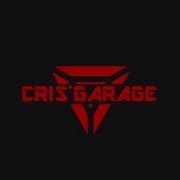
LEGO RC Fiat Panda 4x4
CrisGarage posted a topic in LEGO Technic, Mindstorms, Model Team and Scale Modeling
The Fiat Panda is an Italian utility car created for all needs. It's known for its simplicity but above all for its ability to do almost everything. The 4x4 version, despite the 50 hp, is capable of climbing on various types of terrain, in fact it is also used for trials (just change the wheels). I wanted to create it in a small offroad version. The design is quite similar to the real model even if with some difference like the roof. I added a front bumper with 2 PF Lights, very useful for night rides, and a winch (you can see how it works at the end of the video). 1 PF L Motor for propulsion with a 2 speed gearbox and a 4x4 transmission without differential (I added a second reinforcement gear in the rear axle). The gearbox is compact and strong enough and the winch system is connected to it. The total gear ratio is: First Gear 1:3.33; Second Gear 1:1.67. Pendular suspension for good stability on rough terrain, even if the model is not high enough to work properly :(. The rear opening hatch and the small trailer are good for transporting small loads. The old model was very squarish and very low so I had to revise it more carefully. -
Hello everyone! I´m really happy to present you my next MOC, the Milka truck, which is my 6th remote controlled vehicle at minifig scale! I have built it between December 2018 and March 2019. I have already shown it on two Lego events in Germany, there is an article about it on Zusammengebaut and there is a video on Youtube, in which I am interviewed. It is in German, so if you understand it, it is worth to watch it! Unfortunately I have found only now the time to make some pictures and an own video: The video is a new record from me. It contains the most visual effects among my other videos. I was very happy during the making of it, because last time I have made only rarely videos. It was nice to spend a time again with the camera. It took a little bit longer, as I planned. Because of the complexity I had to record some parts not only once and it was very time consuming to create some scenes on the computer. I´m really proud of the result, hope you will like it, too. Till now it is the most simple and most difficult tiny RC from me at the same time. Simple, because the technic costruction inside is very compact. Difficult, because the modelling of the Scania front and the letters of the word “Milka” meant a really big challenge for me. Now you can find the electric parts just simply near each other in the truck, and the chassis is under the electric parts. It is only 3 studs high. Earlier in the same vehicles you could find 3 pairs of gears, which brought the power from the motor to the wheels. Now it is only 2 pairs. The servo motor for the steering is exactly there, where we need to have it. It can steers the wheels directly, without any long and big construction. The original plane was that I put the receiver or the battery box in the trailer, but finally I found a place for all the parts in the truck. For the chassis I have used a lot of half liftarms and small pieces of rigid hoses. They are very good here, because I can cut them in for example 1 or 1,5 stud long pieces, too. In the truck the battery box is exactly over the driven wheels, so the truck can go very reliable on terrains, which are unfriendly. I mean, it can go up to the pedestrian area in a Lego City and it can destroy everything. The whole truck contains approx. 1020 parts. Most of the bricks are in the body. You can read the world “Milka” on the sides four times, but all the four sides are different. It is changing, how I could fit the side panels, what kind of other parts they have to hold, or how many place I had in the truck near the motors or the other things. During the designing of the cabin, I was afraid, that it will be ugly with the big white panel on the top, but finally I think, it´s ok. If you would like to see and try the truck in real life, visit the Bricky Way 2020 Lego exhibition in Györ, Hungary. It´s not far from Vienna. 7-8 March, 2020! Facebook: https://www.facebook.com/brickyway These are the infos, which I wanted to share you about my newest creation. Hope you like it! :)
-
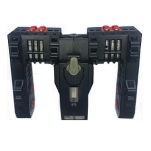
[MOC] X-MARXX 8rc, 8 buggy motor and 4 BuWizz rc car
Marxpek posted a topic in LEGO Technic, Mindstorms, Model Team and Scale Modeling
Hello all here is my latest build, inspired by the Traxxas X-MAXX 8s remote controlled car. The idea was to build a car as "compact" as possible while using 8 buggy motors, 2 for each wheel to give it decent power, as you might notice the buggy motors are at a 90 degree angle from each other, this is to prevent them sticking out the front and back, the chassis needed tall shock towers anyway so it was a nice fit. The front suspension and steering is built fairly sturdy, however crashing with this power, you can brace all you like, it is just going to break as you can see in the video.. The newer type cv-joints are used at the motor end, but since i did not want to use the new hub with its reduction, i used the "old" cv joints with the hubs, and yes, it does "eat" the joints and/or the hubs when something is not sitting correctly. the front has a dampener, a large thin pneumatic actuator, normally hidden by a panel, it is shared with both sides and does.. very little.. but is was fun to integrate. The front springs are from the 8420 motorcycle, adjustable in stiffness, but less stiff them most people imagine them to be, these just seems to fit the build, sadly i didn't have more yellow ones for the rear. The steering uses 2 servos, not only to give it more torque for steering, but also to help reduce the slack from the gear rack to the 12z gear, The two 12z gears on the rack are both offset by 1 tooth, but against each other, the long axle going to the servo's are under a bit of stress but nothing serious, it really helps reducing the slack on the steering. To further prevent slack from the hubs they are steered with the front links and stabilized the rear links, the next picture shows the 2 gears on the same rack (car is upside down), you can also see the imprint of a 5L axle from the bumper on the 5x7 frame after a crash.. The rear suspension has the same drive setup, but since it is more fixed and less likely to get damaged in a crash, it never destroyed any joints or hubs, here i also integrated dampener in the form of small pneumatic actuator on each side, which again.. do very little.. but was fun to integrate, it also has a torsion bar going from one axle to the other to prevent body roll, let's just say it was fun to integrate :) The grey springs are the exact same as the yellow ones, but these come off the Lego 8369 rc "dirt crusher" set, i happened to have these 4 spring, considered to get 2 more yellow ones, then i saw the price.. and went with mismatched colors.. so please forgive me i cheaped out... The body started out as a crawler body, and got heavily modified, extended in every way, added 4 seats for Technic figures and a new color scheme, It is fully detachable with 5 pins. The front and rear lights are in the chassis but they line up perfectly with the translucent bricks on the body, making it easy to get to the buwizz for charging or turning them on. The video and pictures have some inconsistencies in them, i know.. but i have had 3 horrible crashes, that required rebuilds plus some roadside repairs here and there, some i forgot to give the proper fix later on.. shooting the video took me a bit longer because of the same reason, i need to practice my driving skill... or not go to a skatepark when it is wet... or just not build in overkill mode... Thanks for reading! if you have questions or comments, feel free to ask of course! Marx. -

[MOC] Flatbed Tow Truck
KevinMoo posted a topic in LEGO Technic, Mindstorms, Model Team and Scale Modeling
Hi, everyone! It’s been a long time since I posted my last MOC on EB. Today I’m gonna show you one of the projects I’ve been working on lately: a flatbed tow truck / US style wrecker. This is the biggest MOC I’ve made so far...And it is packed with loads of features & functions. Some general specs: Weight: over 4 KG Parts used: over 3800 pcs Dimensions: 760mm (L) x 170mm (W) x 220mm (H) It features: - V8 fake engine - Openable doors - Working headlights - Independent suspensions on front axle - Pendular suspensions with shock absorbers on rear axles Motorized functions: There are 8 motorized fuctions in total, powered by 9 PF motors, remotely controlled by 1 IR Controller + 1 IR Speed Controller (channel switching on both controllers is needed), simple structure with no gear box: - 2 XL for propulsion - 1 Servo for steering - 1 M for opening bonnet - 1 M for wheel lift lowering & raising - 1 M for wheel lift reaching out & retracting - 1 M for bed tilting - 1 L for bed sliding - 1 L for winch A video showing all functions: (Original video on YouTube is 60fps, don’t know why it doesn’t work here) I managed to hide all motors inside the chassis, including the one that powers the winch. I’ll talk about it later. Some more video clips: (Again, all 60fps) This is the propulsion motors assembly. 2 XL hard-coupled with 12-teeth bevel gears, and has a total gear ratio of 25 : 9 before power reaching rear-axle differentials. That’s enough torque to propel this heavy truck. Rear axles have pendular suspensions, connected by 3 small turntables. Soft springs are for balancing. Structure is solid enough to bear the load, but I also designed a similar one with extra support on the middle turntable. It’s 1 stud longer so I didn’t use it on this already long truck. This is what the chassis looks like.I was wearing latex gloves for anti-sweating... Eight 200mm-long PF extension cables were used to connect motors to IR receivers and IR receivers to battery pack. They were well hidden right underneath the battery pack. Now let’s take a look at the bed. In the picture above, the arrows indicate how power goes up the bed. Red ones are for bed sliding while green ones are for the winch. I decided not to put a motor on the bed because it is ugly and too big. A real flatbed’s winch motor is fairly small compared to its size and usually unnoticeable. As a result, I have to compromise on deck height... More photos: At last, I have to say I’m not satisfied with this MOC for several reasons: Deck height: just too high for a flatbed. As I will not compromise on a visible motor on bed, height increased at least 3 studs. Loading angle: about 19 degrees, not a good number Most importantly, too long and too heavy. Front wheels and Servo are working under high pressure, even with 3 hard springs on each side the front part is still overburdened. Perhaps an extra pair of wheels in the middle would solve the problem, but it will lose its aesthetics and no longer looks like a longnose US truck. I didn’t want to publish it at the beginning because it’s imperfect, but I spent too much time on it and don’t want to waste it, so finally created this topic and shared it with you. Again, see my other creations on Rebrickable at: http://rebrickable.com/designer/musenkevin And my YouTube Channel: https://www.youtube.com/c/KevinMoo Enjoy! -

LEGO Porsche Tiger GuP.ver
NABLACK posted a topic in LEGO Technic, Mindstorms, Model Team and Scale Modeling
Hello everyone, my name is NABLACK and this is my first post. This Porsche Tiger tank is from an anime called Girls und Panzer. It's mostly a normal Porsche Tiger but with a function to boost the performance. And to achieve that "boosted performance" in my Lego Porsche Tiger, I stupidly put 12 PF L motors into it. I got a lot of inspiration from Sariel's Tiger XL and Tommy Styrvoky's Tiger (P), and a lot of thanks and respect to them. Maybe there's too much Tiger tanks around there, but since I was planning to achieve a different feature, I think it would be fine to have another. Hope you will enjoy this. Specifiction: Scale: 1/18 Weight: 2.57kg (5.67lbs) Length(without barrel): 37.5cm (14.8in) Width: 19cm (7.5in) Height: 17cm (6.7in) Suspension: Oscillationg Bogies Power Source: Buwizz 2.0 x3 Propulsion: PF L motor x12 Gear Ratio: 1:1.667 Top Speed: 5km/h (3.1Mi/h) Other Electronic Parts: PF M motor x1 for turret rotation; PF M motor x1 for gun tilting; a pair of LED light Parts that's not original Lego: Buwizz 2.0 x3; Stainless steel axle x10; Stickers _DSC9262 by NABLACKS, on Flickr _DSC9265 by NABLACKS, on Flickr _DSC9283 by NABLACKS, on Flickr _DSC9290 by NABLACKS, on Flickr _DSC9282 by NABLACKS, on Flickr _DSC9297 by NABLACKS, on Flickr _DSC9301 by NABLACKS, on Flickr _DSC9302 by NABLACKS, on Flickr _DSC9449 by NABLACKS, on Flickr _DSC9479 by NABLACKS, on Flickr Visit flickr for more photos -

[MOD] Motorized 42056 PORSCHE 911 GT3 RS
MODORO posted a topic in LEGO Technic, Mindstorms, Model Team and Scale Modeling
Jan-'17 Now, building instruction file (PDF) is available at Rebrickable linked below http://www.rebrickable.com/mocs/Modoro/motorized-42056-porsche-911-gt3-rs-version-11 ------------------------------------------------------------------------------------------------------------------------------------------------------------------------------------------------------------------------------------- Hi.. everyone! This my 2nd posting here, introducing my own renovation(or remodeling) of TECHNIC 42056 PORSCHE 911 GT3 RS. Among the newly released 2016 Lego models, "TECHNIC 42056 PORSCHE 911 GT3 RS" received the best attention before release. In addition to its nice and detailed appearance, now I attempt to review the process of blowing features including RC driving and 4-speed gearbox shifting, and LED lights as well. The video above shows the process of remodeling TECHNIC 42056 PORSCHE 911 GT3 RS and a driving test in the following order. The process of remodeling each part of PORSCHE chassis Driving and steering test of the remodeled PORSCHE chassis The process of binding the renovated chassis to the PORSCHE body Field driving test The main target of this RC remodeling is just a chassis (or power-train) that is composed of front/rear axis, power transmission and steering units. The following figure compares the before and after appearance of the renovated PORSCHE chassis. <Before> <After> The changes and features of the renovated PORSCHE chassis are as follows Mounted drive motors (L-motor x 4) Mounted a steering motor (S-motor x 1) Modified gear shifting method not using the paddle shift remodeling of the 4-speed sequential gearbox for enhanced durability and power transmission efficiency Mounted PF battery (optionally, two batteries) Mounted two SBRICKs for the remote control capability While including all of the above modifications, it maintains the design and major features of the original 42056 model. (rear fake engine room, Hand of God, glove box, toolbox under the hood etc.) This review is divided into a total of 9 sections, and the following videos illustrate the building progress of each section, respectively. part 1: chassis frame remodeling In this section, the main contents of RC motorizing 42056 PORSCHE chassis is largely divided into three sub-parts and will be described as follows . 1) reinforcement of chassis regidity A dictionary meaning of chassis frame is defined as "the frame plus the "running gear" like engine, transmission, drive shaft, differential, and suspension" In the original 42056 model implementing the real PORSCHE 911 GT3 RS in LEGO model, a chassis is composed to support the body, transmissions, front and rear axis, engine etc. By the way, LEGO designers did not consider the RC driving from the stage of planning the TECHNIC 42056 model. Thus the chassis regidity, weakened by adding driving & steering motors, gear-shifting motors and battery boxes, cannot maintain the body shape of its own secure and inhibits the stable driving performance. In order to reinforce the chassis regidity that is more weakened by removing liftarms to mount 4 driving L-motors under the gear-box, 42056 chassis core is newly configured using a total of thress TECHNIC 5x11 liftarms. 2) provision of driving motor mounting space 4 driving L-motors are mounted under the gear box between the driver and front passenger. 3) provision of gear-shifting axle mounting space In the original 42056 model, The transmission and drive shaft axis are designed in the form perpendicular to each other. According to this design, gear shifting can be done accurately, smoothly and sequentially from 1st speed to 4th speed. However in the driving test progress, it turned out that thress 24-toothed bevel gears in driving pathways can not deliver high torque & power to the rear axle and differential gears. Thus, to remove three bevel gears in the pathway of the remodeled 42056 chassis, gear shifting axle is heightened by 3L and driving shaft is connected right to the 4-speed transmissions. part 2: 4-speed sequential gearbox remodeling part 3: control units for the RC gear shifting part 4: driving motors mounting part 5: dashboard remodeling part 6: front/rear axis remodeling part 7: rear engine room remodeling part 8: assembly process of the renovated PORSCHE chassis part 9: binding the renovated chassis to the body of PORSCHE These are all I prepared for the review of the motorized 42056 PORSCHE model. Thanks for reading & watching (-; -
It's official: what we've been doing for the last half of year together with LEGO was turning a real-life Liebherr R 9800 into an RC model. And guess who drove it :D More video content will follow soon! My behind-the-scenes video: And finally, here's a brief behind-the-scenes video from LEGO:
-
Hi again, Not too much to say about this one. I wanted to build an A Team Van, so I did. Features - 1x L motor at 1:67 - 1x Servo - 1x M Motor for side door - 1x M Motor for back doors - functional doors & hood - battery access under van - working front lights - 42Lx17Wx16H (chassis, in studs) - 1242g Any comments are appreciated. Thanks
-
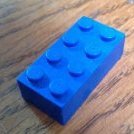
Self Balancing Motorcycle With Leaning Driver MOC
MaxBrix posted a topic in LEGO Technic, Mindstorms, Model Team and Scale Modeling
This model balances on two wheels and the driver leans to tip the bike over to steer.- 5 replies
-
- rc
- motorcycle
-
(and 2 more)
Tagged with:
-
Volvo H9X Specification of the excavator Length 60s / width 31s / height 20s (47/24,5/16 cm) - without excavator arm Max dimensions of excavator arm: 60x35 cm(length x width) Weight: 3637 g Front suspension: none Rear suspension: none AWD Steered both axles Power - 2x 8878 BB 3x M 4xL 2x XL 3x Servo Specification of the trailer Length 55s / width 25s / height 17s (44/20/13,5 cm) Weight: 1398 g Power: 1x 8881 BB 1x XL Functions Driving - 2x XL Steering - M Gearbox - M Lifting the blade - M Excavator rotation - L Movement of the arm - 3L + 3 Servos Lifting the trailer's tipping bed - XL Today, I want to present wheeled excavator Volvo H9X with trailer. Model was built for Lego contest „Build the construction machines of the future”. Later it received many improvements… In short: it is wheeled excavator without operator’s cabin. I didn’t pattern the model on any real machine. As a scale I took Claas’s wheels. For driving there are two XL motors, which drive the 4 wheels, through two-speed gearbox. First gear ratio is 5:1, and second 1,8:1. The gears are changed by M motor and two 1x7 racks. Both axles are steered by M motor with gear ratio 3:1. In the front there are blade, driven by another M motor. In the upper part of the excavator there are three comperssors for three pnematic functions. First, which drives the four big pnematic cylinders, consists of L motor and two pnematic pumps. Next two compressors are the same (L motor + one pump) and they drive the pneumatic cylinders for moving second section of the arm and the bucket. The valves are steered by three Servos. For excavator rotation I used L motor with gear ratio 155:1. In the front there are double Led lights, powered by a switch. The trailer is a simple liftarm construction. The bed is tipped by one linear actuator driven by XL motor. It is powered by switch, because of lack of free channels on the IR receivers. Gallery
-
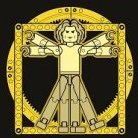
[MOC] The Wannabe Tatra
Attika posted a topic in LEGO Technic, Mindstorms, Model Team and Scale Modeling
Good people of Eurobricks, let me give you my first take on the planetary hubs: Please excuse me for the lenght of the video, it's meant to show the developement stage by stage. I had big expectations towards the new hubs, since they've been announced. I realised, these hubs will solve the problem of the stress on drivetrains, yet will raise a new challenge. Due to the increased torque on the wheels, the frame (chassis) and the bracing of the suspension will be the new weak link. A wanted to have a finalized rig to the date of the release of the hubs. The backbone of the design came from a five years old chassis concept, it was a non motorized chassis: To mimic the geometry of the new hub, I've used the old ones with some extension, so it can be easily swapped, when time comes: The concept of the chassis came together quite well, thanks to using techniques well practiced in my early years. But there was still a long time till the release of the new hubs. Driven by curiosity, I've planted two PF XL motors in the middle of the chassis, making them drive two axles each. One for the front axles, one for the rear ones. No additional gearing has been added, the motors were connected straight to the differentials. Of course it had to be tested, hat's the part around one minute into the video: https://youtu.be/PGQpUrOS-NQ?t=59 Came with a surprisingly satisfying result, despite the usage of the old cv's and hubs, yet it was understandably far from being a "crawler" it meant to be. Also at this point I was short of claas tyres, so I've used some similar size rc tyres on the front 4. Got the tyres eventually, still a lot of time till the hubs coming though. As the final design was gonna use 4 buggy motors, time came to make the change: Same principals, like with the XL motors: No gearing added (slow output used), 2 motors drive the front, other 2 for the rear axles. Now feeding that much buggy motors would require 4 buwizzes. Or one well sized rc lipo that can comfortably supply 2 sbricks. 4 buwizzes cost about 400-450 pounds, while the lipo comes for 30 pounds. Any question? At this stage (still no new hubs) it was an obvious, yet pretty crazy idea to hit the tarmac. So I did. That's what you see at 2:16 in the video: https://youtu.be/PGQpUrOS-NQ?t=136 I had a lot of trouble that day with the bluetooth connection, brought a head on crash int o a container. It was heart-, but no plastic breaking. Finally the hubs came by the post and the picture got full. I've also planted another servo for steering (2 in total now) Indoor durability test at 3:27 https://youtu.be/PGQpUrOS-NQ?t=207 Climbing test (60 degrees) at 4:18 https://youtu.be/PGQpUrOS-NQ?t=257 Hereby I apologize for the dark enviroment at this recording Peek on the suspension at 3:12 https://youtu.be/PGQpUrOS-NQ?t=191 Lego should not be used outdoors... ahm, okay... Outdoor test from 4:55 in the video. https://youtu.be/PGQpUrOS-NQ?t=295 I came to the verdict, that the new hubs worth their money. In a usage that abusive, you see in the video the hub-cv connection definitelly require some lubrication. I've been using silicone oil and no downside appeared so far. Here is the difference it makes: That's it so far, a little spoiler at the end of the video. Hope it's gonna catch some expert eyes...- 8 replies
-
- planetary hub
- 8x8
-
(and 4 more)
Tagged with:
-

[MOC] RC Small Red Roadster
syclone posted a topic in LEGO Technic, Mindstorms, Model Team and Scale Modeling
Welp, back onto 1/15 scale Made this little thingy in about 12 hours after Madoca's small supercar popped up in my YT recommended. BRICKSHELF (whenever uploaded) As with my Mini Nitro Menace, this year's Corvette wheelbase was taken as a base - should be compatible with the transporter truck - and so the build began. Of course, drive&steering has been done a million times already so this needed a cherry on top - the roof was what I was looking for. Making a chassis was dead easy with the slim wheels and by motorising each rear wheel independently, the need for a differential was eliminated. Thanks to the placement of the BuWizz in between the rear wheels, steering and roof motors could now populate the central tunnel and be hidden under the black 3x11 curved panels giving the interior a "cleaner" look. Now, bodywork ain't my strongest point, but I wanted it to be ferrari RED. This meant working with a very small inventory (for me) most of which you can see on the car Of course ricer butterfly doors were made to make it look cooler than it is. Have a nice weekend, Cya) -

[MOC] RC Police Motorcycle (futuristic)
syclone posted a topic in LEGO Technic, Mindstorms, Model Team and Scale Modeling
Good Day. Got inspired to build this after an in-game motorcycle from Honkai impact 3rd Original idea was to use 2x XL motors, but it was boring af. Next obvious step were buggy motors - allowing an approximate speed of 10km/h. It could probably pick up a higher speed with BuWizz 2.0's Ludicrous mode, but fast mode of BW v1.0 is enough to topple the bike over when taking high-speed turns. Unfortunately it does require "training wheels" to ride straight, as it would lean on one side without those after taking a curve without those. The bike does feature rear axle suspension, and small wheels have shocks as well. "01" stickers reused from MPATEV, "police" from 42047. Design-wise it belong to the same "universe" as my spaceship and racers - an Axos Police bike used to patrol within city high-speed tunnels and surface operations. Video&photos, C&C very welcome and appreciated))) Cya later!- 7 replies
-
- bike
- futuristic
-
(and 3 more)
Tagged with:
-
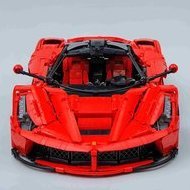
[MOC] RC Audi S3 Quattro with BuWizz
T Lego posted a topic in LEGO Technic, Mindstorms, Model Team and Scale Modeling
After a long and difficult builing proces, the project is finally done. The project started in early may, when I created a WIP topic here on EB. In the end, I set the bar a little bit too high as I was not able to get all the desired features inside. Audi S3 quattro Specs: - Dimensions: 44x19x14 studs (L x W x H) - Weight: 1300g - Estimated part count: 1800 parts - 4 PF motors Features: - Opnable doors and bonnet - Ajustable seats (2x HOGs) - All wheel/quattro drive with three differentials (2x PF L motors) - Steering (PF Servo Motor) - 4 Speed sequential gearbox (PF servo motor) - BuWizz 2.0 Power - Complete detailed interior with no mechanics/electrics visible I tried to use as many panels as possible which is IMO essential to get the best looking bodywork. This model consists of 45 technic panels. The stepper mechanism (located underneath the roofspoiler) used for the gear shifting is increadibly simple and works very well. The chassis is very stiff. the car can easily be lifted from the roof without damaging anything. To open the bonnet, you need to tilt and pull it at the same time. The LBG pin/axle connector slides trough the 5L axle with stop when you pull the bonnet. This system was necessary, beceause othewise the bonnet would have interference with the dashboard. Like in most of my other builds, I pay a lot of attention to the interior. I never want mechanisms visible or motors inside. You will find many details in the interior, like a handbrake, steering wheel, gear lever and door handles. When you pull the red part in the center up, the buwizz turns on/off. Too bad that the center dail which is placed upside down though. The seats can be ajsuted forwards and backwards by rotating the tan 20th gear. It is a very simple setup consting of a few gears, a worm screw and a 1x7 technic gearrack on which the seats are mounted. The building proces may be very interesting to read (if you have not seen it yet). Many interisting ideas and suggestions were posted that are not shown in this model. For instance, it should originally feature (air)suspension, but due to the airleaks and absence of differentials, it couldn't take corners propelry enough. Thanks to everyone who helped me with this build! You can check it out here: I wanted to make a video of it today, but my buwizz onstantly cut off power so give me a few more days... I won't make instructions, beceause I am busy working on intructions of another model which I will show this year as well. I hope you like it. Comments, feedback and constructive critisism are as always highly appreciated! -

[WIP] Audi S3 quattro 1:12 RC - finished
T Lego posted a topic in LEGO Technic, Mindstorms, Model Team and Scale Modeling
Yes, yes yes... I am going to build another Audi After a very good result of my previous Audi, I thought with those design parameters I can't make a better car. Therefore I wanted to do something different, yet similar. I am going to scale up (slightly), and add a bunch of new features. I also realised that performance of the result won't be comparable to the previous one. The main reason for that is, that I am not going to use buggy motors. I recieved many questions like: "can I build it without expensive buggy motors?'' . I will be using these wheels: https://www.bricklink.com/v2/catalog/catalogitem.page?P=41896c04#T=S&O={"iconly":0}. I want the car to be 19 studs wide and have a wheel base of around 25 studs. The design parameters are: All wheel drive (quattro) with a central differential and without diffs on the axles. Front and rear independent suspenion. 50-50% (or close) weight distribution Servo steering (perhabs with steering wheel) Driving using two L motors 4 speed sequentail gearbox (servo operated) A good looking bodywork that reflects modern Audi's A good looking interior without any electronics/mechanisms visible Funcionality does not compromise for aesthetics (previous version is a great example) BuWizz power I allready have made some progress on the front axle. This is the result of many hours of puzzeling. It meets the requirements mentioned above. The buwizz is located behind the front axle and underneath the future dashboard. Axle for driving runs underneath the buwizz. I used these parts for the steering rack. It is connected to an eight tooth gear. On the same axles sits a 16 tooth gear which connects with the 20 thooth gear connected to the servo. The turning radius is great. I used these parts to stabilize the CV joints The next step will be to design the gearbox and rear axle. They will be integrated to save space. Comments, questions and feedback are highly appreciated! -

[MOC] Mini RC Nitro Menace (8649)
syclone posted a topic in LEGO Technic, Mindstorms, Model Team and Scale Modeling
Having finally set free the buggy motors from TC16, it was time for something speedy again. Having seen the new 2019 transporter, that scale got me again, so making a car "compatible" with that set was very interesting. And having 8649 box on display made it clear which one I wanted 2 make. After a day of non-stop building this abomination somewhat resembling the original was born: The build was based off this year's Corvette wheelbase - 20x15 studs. 8649 has oversized wheels, giving it a cartoony apperance, but that wouldn't work for this one as space in the rear was required for a double buggy motor setup. Low profile tires in combination with old rims were a perfect tuner combo and gave resemblance to the 68.8 six spoke wheels. This also allowed to place the rear wheels much closer to the buggy motors using a non-standard 36z - 16z gears combo (1:2.25) with half-stud on-axis offset [see picture below] powered through the slower, outermost motor output to an approximate 2000rpm to the rear wheels. This gear combination resulted quite reliable when braced properly and withstanded all crashes, slides and racing that was thrown at it. In contrast, the front axle is a real mess. Having to place the m-motor right after the BuWizz made it really weak, and the flex axles make it hinge forwards. It does stay in place though due to all the bracing, so good enough? Also low-pros are amazing for drifting, which makes this vehicle very enjoyable to play with . Bodywork-wise it is NOT a "modern beauty" but carries the approximate lines of the original model. All the interior details are present - double NOS bottles in the rear, Red bucket seats and a tuner steering wheel (RHD version for some JDM powah ). Supercharger was a no for me - it looked terrible on the original. Big a$$ exhausts were kept to annoy the neighbours In the end it is not fully compatible as it probably wouldn't be able to drive up the ramps, but does drive cool. Welp, here's the video and LDD file https://rebrickable.com/mocs/MOC-26855/syclone/mini-rc-nitro-menace-8649/ Best Regards, Dan. Cya later!!! -
MPATEV-01 -> Multi Purpose All Terrain Vehicle 01 LDD file DOWNLOAD The attachments and other photos: WIP TOPIC MPATEV-01 -> Multi Purpose All Terrain Vehicle 01 Hello there! haven't been on the forum for some time and seeing such a contest pop up was a truly delight. Of course first ideas were of the movies "Martian", "Avatar", and "Interstellar", and the idea of building a spaceship seemed exiting. Therefore, i made a sketch of a VTOL transport ship: However building a freighter or a spacestation didn't exite me so much afterall (absolutely nothing to do with my unfinished tc15 plane ) so the next obvious idea was a rover. A human-manned one of course. Seeing that the currents WIPs were using wheels, I had a quick browse through lego sets of space/sci-fi themes and quickly found the Exo-Force 8118. It had a combination of double tracks in front and a single wheel in back that got me interested, as it was unusual and cool-looking, so this sketch came to life: It was originally planned to use brick-built tracks on front but small track links with turntables for central wheels should work. Most probably double offroad motorcycle tyres on rear (better start saving up for PP wheels duh). Obviously doubly buggy motors with 1.667:1 reduction + nuclear reactor BuWizz to power this thing. Current progress:
- 17 replies
-
- buggy motor
- mars
-
(and 3 more)
Tagged with:
-

[MOC] RC 4x4 Pickup N2
syclone posted a topic in LEGO Technic, Mindstorms, Model Team and Scale Modeling
Good Day everyone! After completing MPATEV-01 (video&LDD file coming soon) and not able to progress on Saber, decided to build something from my bucket list. And there was 8258 B. After a somewhat boring build process the final result was not very satisfying, so my first idea was to motorise it. However keeping the model as it is would be extremely boring, so the whole chassis and rear part were dismantled, leaving only the front, bonnet and hoods . Next a 4X4 (AWD probably but you've been clickbaited mwahahah ) with open diffs was made. No reduction from the XL motor but the one in-between driveshaft and diffs. On front there are two gray (old gray - undetermined type) springs and on the rear a leaf axle out of 9l links (idea by ZBLJ). Of course that horrendously enormous fake motor was kicked out and substituted with a cute mini V8. Interior is as crude as the original but now with even less foot space and a switch under the dashboard. Steering through M motor and hockey spring combo, M motor-powered winch controlled with the LBG connector on dashboard. For power I opted for a "classic" PF receiver and custom wired 9V battery neatly fixed with a net in the bed. Overall not the best performance but it's quick yet (relatively) powerful. Front winch is detacheable to improve climbing angle (approximately 50 degrees maximum). I haven't named it a MOD because most of it was made from zero, and the N2 is because this is a successor to one of my early RC MOCs - pickup N1 https://www.eurobricks.com/forum/index.php?/forums/topic/127500-moc-4x4-off-road-pickup-n1/ (my imitation of 9398 as I couldn't afford one and still can't) LDD file DOWNLOAD Video: (sorry it's 30° outside, batteries died and I ain't frying myself 2 times for some offroading outside ) Have a nice weekend, Cya later!






